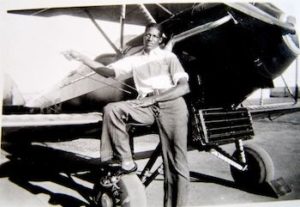
Frank Mann, Waco, Tx with his Bio-Plane
On this date, we mark the birth of Frank Mann, a Black engineer and designer, in 1908.
A native of Houston, Texas, Frank Calvin Mann's parents wanted him to become a schoolteacher, but from childhood, he had a natural ability to fix things. At age 11, he had his mechanic shop. As a teenager, he worked alongside airplane mechanics, repairing engines. By age 20, he had designed and built several of his Model-T cars. It was unheard of in the 1920s for a Black man to have anything to do with cars, trains, or airplanes. His life-long friend Howard Hughes was instrumental in opening doors for Mann's exceptional talents.
Mann attended the University of Minnesota and UCLA, earning a mechanical engineering degree. World War II equipment that revolutionized military weaponry would not have existed without his involvement. Mann was the first Black commercial pilot for American Airways and a distinguished military officer. In 1935, Mann flew reconnaissance missions for the Ethiopian army during the Italo-Ethiopia War.
He served in the World War II Army Air Corps and was the primary civilian instructor of the Tuskegee Airmen in 1941. He left Tuskegee after a rift with the U.S. government, which didn't want the Squadron, an all-Black unit, flying the same high-caliber airplanes as their white counterparts. A bitter Mann had refused to have his men fly old "World War I biplane crates" because his airmen had proven themselves as equals.
Though they were being given inferior equipment and materials, their squadron never lost a plane, bomber, or pilot, and they were nicknamed the "Red Tails.” After the war, Mann was instrumental in designing the first Buick LeSabre automobile and communications satellite launched for commercial use.
His pride and joy was a miniature locomotive housed in the Smithsonian Institute; Mann also played a principal role in the Amos ‘N’ Andy radio show. He moved back to his hometown in the 1970s. Frank Mann died November 30, 1992, in Houston.